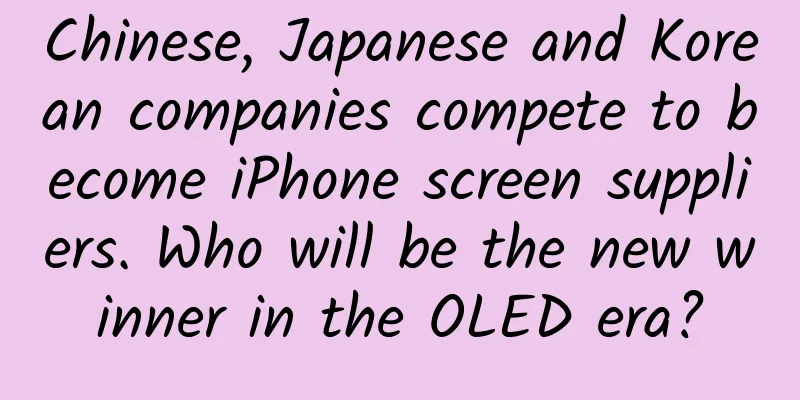Chinese, Japanese and Korean companies compete to become iPhone screen suppliers. Who will be the new winner in the OLED era?

|
The stimulating effect of Apple iPhone X on the market and industry of OLED display technology has surpassed any previous Samsung mobile phone or other display terminal device equipped with OLED screen. According to Samsung Electronics' performance report released in October 2017, the sales of its display division exceeded the 9 trillion won mark for the first time, and the huge demand for Samsung's OLED displays from Apple's iPhone X undoubtedly contributed greatly. On the other hand, the OLED panel used in iPhone X costs about $150 per piece. Samsung, as Apple's only OLED screen supplier, enjoys the high profits brought by Apple's high sales volume with its complete monopoly advantage. This is obviously a situation that Apple, which has been insisting on "de-Samsungization" in recent years, is unwilling but has to accept. However, in 2018, Samsung's position as Apple's exclusive supplier based on OLED technology may become less secure. LGD tries to fight small-size OLED again despite screen burn-in Just as Samsung has a near-monopoly in the manufacturing of small-size OLED panels such as mobile phone screens, LG Display, also a Korean company, has absolute say in the field of large-size OLED panels such as TV screens. However, LGD's journey towards small-screen OLEDs has not been smooth. Not long ago, Google's flagship phone Pixel 2 XL, which uses LGD's P-OLED display, was voted the most disappointing electronic product of 2017 due to screen burn-in issues. Earlier, the Xiaomi Note 2, whose screen display effects were constantly criticized, also fell into LG's trap. However, LGD has no plans to give up its competition with Samsung in the small-size OLED panel market. As previously reported, LGD has invested in building a small-size OLED screen production line. Now, according to Korean media reports, LGD is planning to supply display panels for Apple's 2018 new iPhone with OLED screen starting in the second half of this year. The current planned quantity is more than 15 million pieces. Although this figure is far from the level revealed by industry insiders that Samsung will quadruple the number of OLED panels it supplies to Apple to about 200 million in 2018, for Apple, the shift from a single dominant screen supplier to two competitors is naturally enough to increase its bargaining power in the upstream of product production. In addition, LGD and Apple have a long history of cooperation on iPhone products that have always used LCD screens. If LGD can continue to successfully become one of the screen suppliers for Apple mobile phones in the OLED era, the importance of LGD to make up for its shortcomings in small-size OLED panels is self-evident. JOLED Alliance takes shape, and Chinese manufacturers also become industry variables Of course, it’s not just Samsung and LG that are eyeing the big cake of iPhone screens. Among Japanese companies, the JOLED Alliance, a joint venture between INCJ Innovation Network, JDI, Panasonic and Sony, also chose to focus on the research and development and manufacturing of small-size OLED panels. Its desire to become one of the OLED screen suppliers for Apple's iPhone is obvious. It is worth noting that unlike the evaporation technology commonly used in the OLED panel preparation industry, JOLED prefers a printing technology with higher production efficiency, which directly "sprays" the luminescent material on the designated position through a high-precision nozzle. As early as June 2017, JOLED announced that it had begun producing 21.6-inch 4K OLED panels and planned to produce them in small batches on its 4.5-generation inkjet production line. At the same time, at the end of 2017, industry insiders speculated that it had become the screen supplier for Sony's medical displays. According to the latest news, JOLED is close to obtaining a $440 million investment from Japan's DENSO, as well as planned capital injections of $390 million to $780 million from Panasonic and Sony. After receiving strong financial support at the beginning of 2018, JOLED's role as a Japanese disruptor of OLED panels has been further solidified. At the same time, JDI, a core member of the JOLED Alliance, was reported by Japanese media in late December 2017 to be in talks to receive an investment of approximately US$1.8 billion. The investors were BOE, China Star Optoelectronics Technology Co., Ltd. and Tianma Microelectronics, three panel manufacturers from China, indicating that China's upstream display manufacturers have shown great interest in OLED technology. The vision of Chinese manufacturers to localize OLED screens is no longer a fantasy. At the end of October 2017, BOE held a mass production delivery ceremony for the country's first and the world's second 6th-generation flexible AMOLED production line in Chengdu, announcing the delivery of AMOLED flexible displays to more than a dozen terminal manufacturers including Huawei, Xiaomi, and OPPO. This also took a step forward in the idea that Apple's iPhone would use domestically produced OLED screens, which was once the case for many people. Especially today, the reason for this idea is not only due to BOE's previous display of an OLED "bangs" full-screen display similar to the iPhone X. According to recent reports from Korean media, domestic mobile phone brand Huawei is about to become the first customer of BOE's first batch of dual-curved 5.5-inch OLED display panels and touch modules. According to the latest news from the domestic mobile phone industry, this product is likely to be Huawei's mid-2018 flagship P11. 8K OLED screens are coming, and the large-size panel market is also changing The OLED craze caused by iPhone X is bound to affect the large-screen OLED products and large-size OLED panel markets mainly for TVs. Moreover, not only do TV manufacturers have a new "Apple hotspot" to "take advantage of" when promoting their products, but large-size OLED display technology has also accelerated the progress of catching up with traditional LCD panels in industry segments such as 8K resolution. On the first day of 2018, LGD announced that it had successfully developed an 88-inch 8K resolution OLED screen, taking the lead in winning the world's highest resolution and largest OLED panel to date. Compared with Samsung's current main QLED TV, which is actually still an LCD TV that uses quantum dots to emit light from the backlight source, OLED, as one of the future directions to replace LCD display technology, has shown a more mature side in the large-size field than other options. In addition, before 2018, LGD has finalized its investment in the construction of an OLED panel factory in China. This major project with a three-year plan to invest US$4.7 billion is expected to have multiple positive effects on how OLED TVs can resolve the old problems of high costs and high prices, as well as the panel supply for Chinese TV manufacturers including Skyworth and Konka that will develop OLED products in the future. It is also worth noting that as the momentum of OLED replacing LCD technology grows stronger, more and more TV manufacturers that used to stick to the LCD front are also beginning to gradually change their inherent attitudes. In addition to Sony's launch of the A series of high-end OLED TVs in the market in 2017, foreign media reported not long ago that Sharp CEO Tai Jeng-wu also said that Sharp is asking the Japanese government to help it form an alliance with industry rival JDI in OLED technology. The time may be coming when the "Father of LCD" abandons LCD and focuses on OLED. Therefore, it is not difficult to find that although Apple cannot manufacture OLED screens by itself, the emergence of iPhone X using OLED screens has become the fuse that ignites the upstream OLED industry. Spanning panels of different sizes for mobile phones and TVs, and even the struggle between vapor deposition technology and printing technology, in the new landscape of OLED industry competition that is gradually emerging in 2018, upstream companies in the display industry in China, Japan and South Korea all have the opportunity to change the future of screens in the post-LCD era. As a winner of Toutiao's Qingyun Plan and Baijiahao's Bai+ Plan, the 2019 Baidu Digital Author of the Year, the Baijiahao's Most Popular Author in the Technology Field, the 2019 Sogou Technology and Culture Author, and the 2021 Baijiahao Quarterly Influential Creator, he has won many awards, including the 2013 Sohu Best Industry Media Person, the 2015 China New Media Entrepreneurship Competition Beijing Third Place, the 2015 Guangmang Experience Award, the 2015 China New Media Entrepreneurship Competition Finals Third Place, and the 2018 Baidu Dynamic Annual Powerful Celebrity. |
Recommend
Virtual atlas website training camp project: Matrix station group automated transaction, 3-5 months to achieve rapid profit monthly income of 10,000+
Virtual atlas website training camp project: Matr...
The most powerful growth method for user retention
What is a behavioral model? In fact, it is a habi...
Youth Physical Fitness Course Baidu Cloud Download
Youth Physical Fitness Course Resources Introduct...
Light Course 1.01 covers courses for all grades_Taoduoduo
【Software Description】 All grades can watch onlin...
What kind of flowers make Beijingers go to see them despite strong winds and sandstorms?
The weather has warmed up recently, and everyone ...
Tailing's "I'm Open-Minded" theme event invites you to immerse yourself in stress relief and have fun with Tailing
On September 23, 2023, the 19th Asian Games opene...
How lazy were the ancients? Just look at their handwriting.
How lazy were the ancients? Just look at their ha...
The best time to remove formaldehyde is here, so hurry up and save these methods!
Summer is here and the weather is getting hotter ...
What is the origin of the “UFO” that is flooding the circle of friends?
Let’s learn about some common “UFOs”. When variou...
Case study: Steps to set up a Kuaishou information flow advertising account
The delivery operations of information flow platf...
Youdao Children's Dictionary Pen K3 Review: A super learning partner that can be used from kindergarten to elementary school
For language learning, starting from around 3 yea...
Don't let your iPhone trust your computer at will. This is a dangerous operation.
Although few people connect their phones to compu...
《PIMP Core Notes》Dating Course for Boys
Introduction to the content of the training course...
After doing nucleic acid tests so many times, I finally know where to poke!
Addendum 1: Because I have to queue up for nuclei...
When did Chinese people start eating melon seeds? Emperors of the Ming Dynasty loved them...
If you can't go out to play, you can spend th...





![[Shen Hou Review] Hou Ge's Tiangong Primary Class 7 Video](/upload/images/67cc0a643f7eb.webp)



